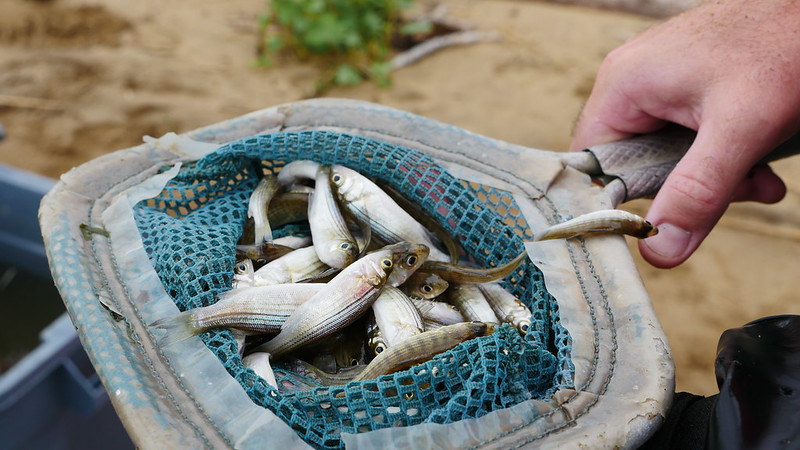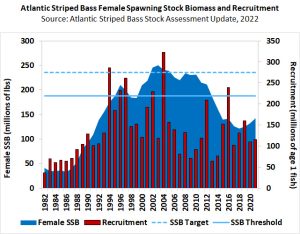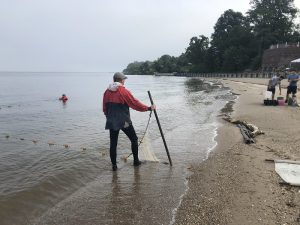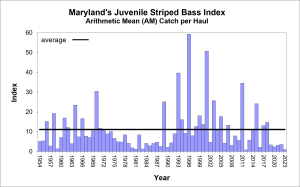Warm Winters, Low Water Flow Are Leading Factors in Poor Striped Bass Spawn
Environmental conditions are likely influencing reproduction in Chesapeake Bay, scientists say

Juvenile striped bass counted during the 2018 young-of-year survey. Photo by Stephen Badger, Maryland Department of Natural Resources.
Environmental factors such as warmer, drier winters and decreased spring water flow rates are likely driving forces behind the diminished spawning success of striped bass in the Chesapeake Bay, according to Maryland Department of Natural Resources scientists.
Striped bass, or rockfish, have had low spawning success numbers for five consecutive years. DNR’s juvenile striped bass survey released Thursday found a 2023 young-of-year index of 1.0, compared to a long-term average of 11.1. The juvenile index, which measures the number of first-year striped bass per sample area, has been below 3.6 since 2019.
Maryland scientists say that these juvenile numbers are concerning, but that continued study and management can help provide for a better chance for a successful spawn in years that present the right environmental conditions.
“Until we start having cold winters and wet springs again, you’re not guaranteed to have that good, successful reproduction by increasing the size of the stock,” said Eric Durell, a DNR striped bass biologist and the leader of the survey project, noting the weak relationship between overall stock size and year-class recruitment. “We have to conserve and build the population to take advantage of the more favorable conditions in the years they occur.”
Despite the low juvenile indices, the adult striped bass population in the Bay remains at a level that has the potential to produce a large year-class, said Simon Brown, a DNR striped bass biologist. The spawning stock biomass for coastwide populations of Atlantic striped bass was 143 million pounds in 2021, which is below coastal management goals but more than three times higher than biomass recorded in the mid-1980s and at a similar level to 1993 and 2015, years when very large year-classes were produced.
That separates the current conditions from the more dire period that started in the 1970s, when low spawning success for more than a decade followed by a diminishing adult population led to a five-year fishing moratorium in Maryland.
“The striped bass stock is not in the same state it was in 1985. This is serious, but we have not returned to that sort of status,” Fishing and Boating Services Director Lynn Fegley said. “While environmental variables may be throwing additional challenges our way, we have a strong management system in place for stock conservation.”
Recent studies by researchers at Virginia Institute of Marine Science and the University of Maryland Center for Environmental Science have bolstered evidence for the suspected link between winter temperatures, spring river flows and striped bass recruitment.
DNR scientists are also publishing research on striped bass spawning behavior and will have peer-reviewed articles appearing in an upcoming issue of the Marine and Coastal Fisheries journal. Jim Uphoff, a fisheries biologist, produced a paper analyzing how spawning stock and larval survival influenced year-class success over the long term. Angela Giuliano, a research statistician, completed a study examining how spawning periods have shifted with temperature changes and considerations for management under changing environmental conditions.
Brown said that scientists can look at winter and spring conditions and make a good estimate of whether the striped bass year-class will be successful or not: Warm and dry winters mean fewer juveniles survive.
Baltimore weather data from the National Weather Service and the National Oceanic and Atmospheric Administration indicates winter temperatures have been warmer than average since 2019, while snowfall has been lower than average since 2016.
Warm winters appear to be associated with lower juvenile numbers because it reduces access to food sources, Brown said. When rockfish larvae hatch, they have a few days where they rely on their yolk sac for nourishment, then they turn to copepods and cladocerans, two types of zooplankton.
However, warm winters could be contributing to a mismatch between striped bass spawns and zooplankton blooms. The copepods that striped bass larvae consume are a cold-water species, and research indicates that zooplankton blooms in the Bay are affected by warmer winter temperatures.
“The zooplankton peak before the fish are spawned,” said Harry Hornick, DNR program manager for striped bass. “After the striped bass larvae hatch, there is not enough prey for them to eat and timely first feeding is critical to their survival at this early stage.”

Female spawning stock biomass is a good indicator of the adult population of spawning striped bass at a given time. The size of the breeding population does not necessarily align with the recruitment class of juvenile fish. Atlantic States Marine Fisheries Commission.
On top of the impact of temperature, low freshwater discharge from Bay tributaries in the spring consistently results in poor striped bass recruitment, Brown said. A cool winter and exceptionally wet spring in 2011 led to one of the largest year-classes of striped bass, while the following year, opposite conditions produced the lowest recruitment number on record.
Eggs and larvae are only semi-buoyant and require the right amount of flow to remain suspended in the water column, and rockfish larvae are visual feeders and can’t find their prey in high turbidity, or cloudier waters, Durell said.
The amount of flow is affected by several factors, including winter precipitation, and the state has seen a period of low flows starting around 2012, Uphoff said.
The spring discharge this year was categorized as moderate in the Choptank and low in the Patuxent, Susquehanna and Potomac rivers, Brown said.
“It’s just that the larval stage is so sensitive to so many things,” Durell said. “The flow and turbidity have to be ideal as well.”
Other factors could also be at play, such as changes in temperature that kill the larvae directly, or another environmental factor that has not yet been identified, Uphoff said.
But other factors all seem to be secondary to winter temperatures and flow, Durell said.
These factors influencing spawning success are separate from other factors that affect adult striped bass, such as warmer water and lower dissolved oxygen limiting the amount of viable space where rockfish can survive in the Bay.

To conduct the young-of-year survey, DNR staff count the number of juvenile fish in each haul of a large seine net. Then they release the fish back into the Bay. By Stephen Schatz, Maryland DNR.
Other anadromous fish that, like striped bass, migrate up rivers to spawn showed poor year-class success in the survey this year, including white perch and yellow perch. These fish have very different spawning stock and fishery status, but share the larval nursery with striped bass. Menhaden and bay anchovy had notably high spawning success this year.
While the adult population of rockfish should be enough to produce a strong juvenile year class, fisheries scientists warn that the effects of the diminished juvenile year-classes will likely become more apparent in the coming years. The juveniles from the past several years will reach maturity, and there will probably be a period of lower abundance of legal-size fish, Durell said.
Yet the years of data show that striped bass are also able to bounce back even after steep declines. Fish reproduce in such high numbers that a few good year-classes could bring rockfish back to stable levels, according to the scientists.
Until then, scientists say it’s important to provide some management to keep the adult population healthy.
“This fish is very resilient, but at the same time you have got to be careful,” Uphoff said.
By Joe Zimmermann, science writer with the Maryland Department of Natural Resources.


 1-888-373-7888
1-888-373-7888 233733
233733